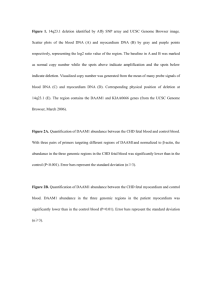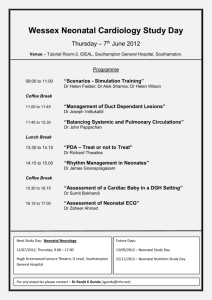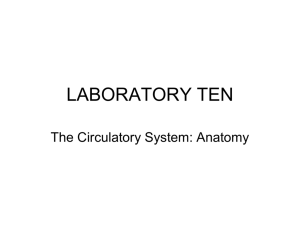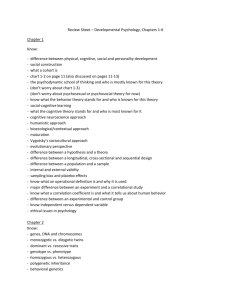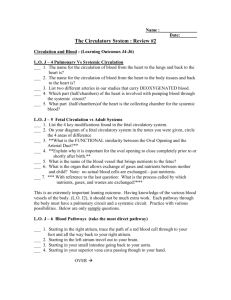General
advertisement
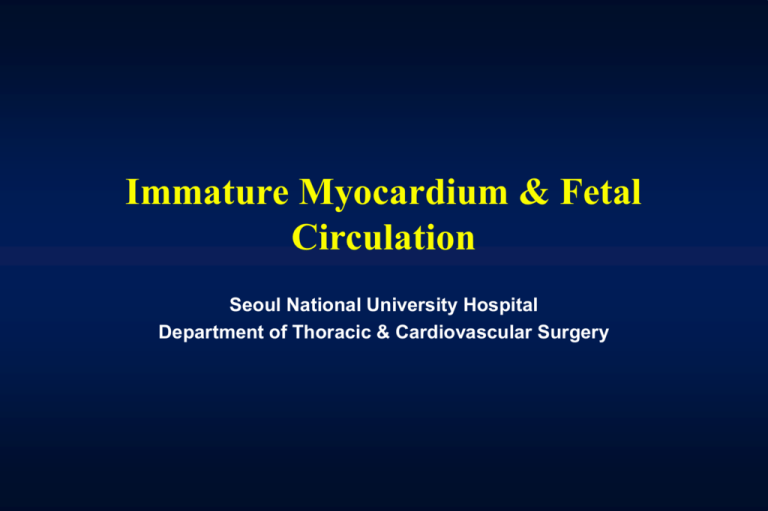
Immature Myocardium & Fetal Circulation Seoul National University Hospital Department of Thoracic & Cardiovascular Surgery Fetal Circulation • Is adapted to a special situation • Depends on placenta for O2/nutrients • Is rarely overloaded, but if overloaded little reserve Fetal Circulation Parallel circulation (combined output) Communications between R and L heart Pulmonary circulation is redundant Flow Pathway and Distribution • % indicates the proportion of combined output Oxygen Saturation of Fetal Flow Normal Fetal Circulation • Major fetal flow patterns and blood hemoglobin oxygen saturation Normal Fetal Circulation • Values for percentages of cardiac output returning to and leaving the heart in normal fetal lamb Normal Fetal Circulation • Values for vascular pressure in normal fetal lamb Normal Fetal Blood Gas Transitional Circulation and CHD • As circulation separates, TGA can not supply enough oxygen to the body • Obstructed pathway in either side hardly tolerate right : PA or critical PS in any CHD left : Aortic atresia or critical AS, IAA, COA mitral atresia + small PFO; obstructed TAPVR Transitional Circulation • Dramatic changes in circulation at the moment of birth and onwards : Air breadth - lung expansion - Rp ↓ Qp ↑ - LA pressure ↑ - PFO ↓ P O2 ↑ - ductus arteriosus and venosus ↓ Obliteration of placental circulation - Rs ↑ IVC pressure ↓ - PFO ↓ Congenital Heart Disease in Fetus • Often silent : TGA : has little effect HLHS : RV is slightly overloaded PA + IVS : no effect at all • When CHD causes volume overload, heart fails and hydrops ensues Neonatal Circulation and CHD Neonatal circulation Potential of increased Rp Potential of atrial communication Compliance of two ventricles is nearly equal CHD and neonatal circulation VSD, PDA : usually not symptomatic ASD : usually not symptomatic Neonatal Circulatory Physiology 1. Decreased compliance of fetal & neonatal right & left ventricle 2. Decreased capacity for peripheral vasodilation 3. Decreased capacity for response to volume load due to diminished preload reservoir Characteristics of Immature Myocardium 1. Greater tolerance to hypoxia & normothermic ischemia in experimental study 1) greater capacity for anaerobic glycolysis 2) greater buffering capacity 3) decreased ATP flux secondary to lower levels of 5nucleotidase 2. Less tolerant to ischemia based on the duration of ischemia at the onset of contracture or intracellular accumulation of sodium and calcium, but recovery of pump function was not assessed by several reports. 3. Compromised secondary to cyanosis, volume or pressure overload with associated ventricular hypertrophy & subendocardial ischemia in clinical setting Normal Neonatal Myocardium Characteristics of normal myocardium • Myocardial structure Myocytes are smaller cells with single nuclei than adult and less contractile materials(30%) than adult(60%), more water, less collagen, more noncontractile protein. Small volume of mitochondria, rudimentary sarcoplasmic reticulum, fewer myofibrils, absence of T-tubules, organization of immature muscle cells in random • Function Velocity of shortening is less. Less compliant myocardium due to increased amount of noncontractile cellular element in immature myocardium Normal Neonatal Myocardium • Response to hypoxia Increased ability to tolerate periods of anoxia due to increased glycogen storage and glycolytic acitivity • Response to ischemia Increased resistance to ischemia , but first 3-8 days of life Early onset of irreversibly injured myocardium than mature myocardium. More reperfusion injury, but rapid recovery without irreversible injury than mature myocardium • Decreased clear ability of lactate production and with stress caused by underlying cardiac disease, which causes high morbidity & mortality. Structure of Neonatal Myocardium 1. Stiffer due to more water, less collagen, more contractile protein 2. Smaller cells with single nuclei, poorly developed intercalated disks, greater mitotic activity, fewer mature mitochondria, and fewer myofibrils 3. Greater storage of glycogen, enhanced rate of anaerobic glycolytic ATP production 4. Calcium homeostasis is different & more dependent on external calcium Metabolism of Neonatal Myocardium • Preference for glucose & glycogen over free fatty acid as energy substrates and greater concentration of glycogen in the heart • Enhanced anaerobic glycolytic ATP production capacity that may represent adaptation to relative O2 deprivation during fatal condition • Significant difference in calcium metabolism (1) Amount of calcium within cardiac cell of neonate is significantly less than that of adult. (2) Decreased ability of immature sarcoplasmic reticulum to accumulate calcium ---- the strength of contraction can be increased in neonate by increasing in extracellular calcium Neonatal Myocardial Management Trend of management In 1990 Equal split in the preference for crystalloid vs. blood cardioplegic solutions In 1995 Trend toward the use of blood based solutions, with only 20% using crystalloid solutions Neonatal Cardiac Surgery Potential for damage duing surgery 1. Preischemic stage Hypothermia 2. Ischemic stage Calcium content Magnesium Single vs. multidose 3. Postischemic stage Myocardial Protection vs. Injury • The surgical treatment of complex congenital heart defects in the neonate requires controlled conditions with unimpaired exposure in a bloodless, immobile operative field. • The cost one pays to obtain such exposure, however, is a period of ischemic insults to myocardium. Effect of Hypothermia The term, cooling contracture, rapid cooling contracture refers to as marked increase in resting in response to sudden decrease in temperature. (activation of myofilaments by the release of calcium from intracellular stores) Damage at Ischemic Stage 1. Calcium content o Optimal calcium concentration(?) o Calcium paradox in acalcemic solutions o PH, Na, duration of ischemia, effects(?) -> Reduction in the ionized level of this cation in the cardioplegic solution results in better myocardial recovery 2. Magnesium o Magnesium help maintain a negative resting membrane potential and competitively inhibits sarcolemmal calcium influx o Superior functional recovery with solution containing magnesium in blood perfused neonatal rabbit model o Optimal concentration is 16 mmol/l citrate calcium level temperature 3. Single-dose vs. multidose o No advantage with multiple administration o More evident detrimental effects at infusion temperatures below 20oC and with increasing frequency of administration Damage at Postischemic Stage After early reperfusion, the postischemic myocardial functional alternation may ensue Intervention aimed at the reduction of reperfusionmediated injury 1. substrate enhancement & ionic modification 2. free radical scavenging 3. leucocyte depletion 4. reduction in perfusion pressure and temperature Protocols for Neonatal Myocardial Protection (I) Preischemic phase o A. Moderate hypothermic (25~28 C) continuous CP bypass, with intermittent periods of low flow (50ml/kg/min) B. Ionized calcium level in the range of 0.5~0.6 mmol/l * fresh frozen plasma (citrate) C. Gas flows are adjusted to maintain PCO2 level at 40~45 mmHg during cooling phase Protocols for Neonatal Myocardial Protection (II) Ischemic phase A. 2:1 blood : crystalloid formulation (Hct 5%) B. Alkalotic cardioplegic solutions may not be a as effective in the neonatal heart C. Initial infusion is at or above room temperature o but is cooled to 10 C Protocols for Neonatal Myocardial Protection (III) Postischemic phase A. Bypass flow rate is reduced to 50% & temperature o 20~25 C for several minutes. B. Ionized level of calcium are not normalized until myocardial activity has returned.

